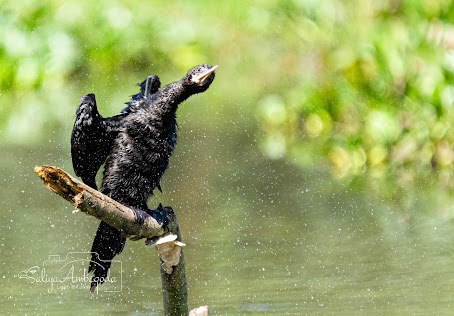I went to Thalangama Lake near Colombo, a calm place with lots of water and plants. My goal was to take pictures of the Little Cormorant, a bird that lives there. While watching them, I noticed something interesting. After diving into the water, they would come back up and shake their bodies to get rid of the water. It was really cool to see!
As the sun begun to rise above the calm waters, I stood by the edge of the lake, waiting eagerly for the Little Cormorant to show up. Suddenly, the bird swiftly dove into the water, disappearing as it chased after its prey underwater.
Moments later, the Little Cormorant came back up, looking like a shadow rising from the deep water. Its smooth body was covered in sparkling water droplets. It gracefully bent its body, causing more droplets to fly through the air in a beautiful way.
I was fascinated by how gracefully the bird moved, so I aimed my camera at the Little Cormorant as it danced in the water. Each time it twisted and turned, water droplets sparkled and flew around, shining in the morning sunlight. It was a breathtaking sight to see.
I was amazed by how well the Little Cormorant could shake off water so smoothly. It's impressive how it's adapted to living in the water over thousands of years. This bird is really good at moving around in the water with ease and grace.
Join with me as we keep discovering the amazing things in nature. Let the beauty of nature lift your mood wherever you go.
The Cormorant's body shaking and water drops spinning out is very fast, therefore I used a shutter speed of 1/2000 seconds to freeze the movement and capture a clear and sharp image. It's very important to highlight the subject from the background, so I needed a very shallow depth of field. To achieve this, I used the largest aperture of my lens, which is f/6.3, at a focal length of 600mm. Then, to get the correct exposure, the only option was to control the ISO speed. Since the bird has dark coloring, I had to use a high ISO like 3600 to 2500 to capture the details of the bird. However, when it spread its wings, more direct light hit them, allowing me to reduce the ISO to 1400
 |
| f/6.3 1/2000s ISO 3600 |
 |
| f/6.3 1/2000s ISO 2500 |
 |
| f/6.3 1/2000s ISO 2500 |
 |
| f/6.3 1/2000s ISO 1400 |



